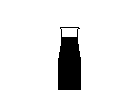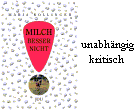 milchlos.de
milchlos.de

 milchlos.de
milchlos.de

Die Ursachen von Autismus im Kindesalter sind nicht bekannt. In den Industriestaaten ist die Anzahl der Betroffenen Kinder kontinuierlich ansteigend.
Bekannt ist, dass eine kasein- und/oder glutenfreie Ernährung meistens zu erheblichen Verbesserungen der Symptomatik führt. Wird die Diät aufgegeben, treten die krankhaften Symptome wieder auf.
Als Erklärung ist folgende Vorstellung entwickelt worden:
Neben den autistischen Symptomen sind bei Betroffenen meist auch Funktionsstörungen des Darms zu beobachten, die zur Durchlässigkeit der Darmwände für größere Eiweißpartikel (Peptide) führen. In der Folge werden viele dieser Peptide vor Ihrer weiteren Aufspaltung in Aminosäuren durch die Darmwand ins Blut geschleust, wo sie dann unerwünschte Wirkungen entfalten können. Bei Autismus, vielleicht aber auch bei anderen Erkrankungen, werden offenbar opioid wirkende Eiweißpartikel des Milcheiweiß Kasein und des Weizeneiweiß Gluten durch den Darm ins Blut aufgenommen. In Studien konnten im Urin betroffener autistischer Kinder unnatürlich hohe Konzentrationen dieser morphinen Substanzen, die Kasomorphine und Gluteomorphine/Gliadinomorphine genannt werden, festgestellt werden.
Es gibt weltweit 3 Forschergruppen, die sich besonders mit der Problematik beschäftigen (Robert Cade, USA; Paul Shattock, Großbritannien; Kalle Reichelt, Norwegen).
Was auch immer weitere Studien ergeben mögen, es lohnt sich immer im Falle der Diagnose Autismus, eine milch- und glutenfreie Ernährung zu testen. In vielen Fällen tritt eine Besserung der Symptomatik ein.
Eine englischsprachige Web-Site, die persönliche Erfahrungen der Mutter eines autistischen Sohnes und wissenschaftliche Forschung beschreibt: http://www.princeton.edu/~serge/ll/gfpak.html
In Deutschland beschäftigt sich die Selbsthilfegruppe "Wir Eltern von Kindern mit Autismus" mit Autismus, Milch, Gluten u.a. Ihre Internetseite ist allen Betroffenen zu empfehlen: www.autismus-wir-eltern.de
Ein detailliert ausgearbeiteter Fragebogen für Eltern, die die Auswirkungen einer Kasein-und/oder Gluten-freien Ernährung protokollieren möchten, konnte unter www.autismus-wir-eltern.de/PDF/Fragebogen.pdf heruntergeladen werden.
Die Ergebnisse der Studien von Robert Cade sind zu finden unter:
www.paleodiet.com/autism/cadelet.txt
"Autism and Schizophrenia: Intestinal Disorders?
Cade R et al. in : Nutritional Neuroscience, March 2000.
We examined Dohan's hypothesis that Schizophrenia and childhood autism are due to the absorption of "exorphins" contained in gluten and casein. We found both diseases are associated with hyperpolypeptiduria with similar peptide patterns upon Sephadex separation. When material from Sephadex separation of urine peptides was separated further by high pressure liquid chromatography, large amounts of gliadorphin and beta-casomorphin-7 were found. Immuneglobulin studies in schizophrenics showed 86% had IgA antibodies to gluten and 67% to casein. Among autistics 30% had IgA antibodies to gluten and casein. High titer IgG antibodies to gluten were found in 87% of autistic and 86% of schizophrenic patients and IgG antibodies to casein were found in 90% of autistic and in 93% of schizophrenics. When schizophrenic patients were treated with dialysis or a gluten-casein free diet, peptiduria decreased and symptoms ameliorated. A gluten-casein free diet was accompanied by improvement in 81% of autistic children within 3 months. Our data provide support for the proposal that schizophrenia and autism are due to absorption of exorphins formed in the intestine from digestion of gluten and casein."
Ein Abstract von Paul Shattock u.a.:
Expert Opinion on Therapeutic Targets 2002 Apr;6(2):175-83.
Biochemical aspects in autism spectrum disorders: updating the opioid-excess theory and presenting new opportunities for biomedical intervention.
Whiteley P, Shattock P.
Autism Research Unit, School of Sciences (Health), University of Sunderland, Sunderland, SR2 7EE, UK. aru@sunderland.ac.uk
Autism is a lifelong condition usually described as affecting social, cognitive and imaginative abilities. For many years, parents and some professionals have observed that in concordance with the behavioural and psychological symptoms of the condition, there are a number of physiological and biochemical correlates which may also be of relevance to the syndrome. One area of interest that encompasses many of these observations is the opioid-excess theory of autism. The main premise of this theory is that autism is the result of a metabolic disorder. Peptides with opioid activity derived from dietary sources, in particular foods that contain gluten and casein, pass through an abnormally permeable intestinal membrane and enter the central nervous system (CNS) to exert an effect on neurotransmission, as well as producing other physiologically-based symptoms. Numerous parents and professionals worldwide have found that removal of these exogenously derived compounds through exclusion diets can produce some amelioration in autistic and related behaviours. There is a surprisingly long history of research accompanying these ideas. The aim of this paper is to review the accompanying evidence in support of this theory and present new directions of intervention as a result of it.
PMID: 12223079
Zwei Abstracts von Kalle Reichelt u.a.:
Nutritional Neuroscience 2003 Feb;6(1):19-28.
Can the pathophysiology of autism be explained by the nature of the discovered urine peptides?
Reichelt KL, Knivsberg AM.
Institute of Pediatric Research, Univ of Oslo, Rikshospitalet, N-0027, Oslo, Norway. k.l.reichelt@klinmed.uio.no
Opioid peptides derived from food proteins (exorphins) have been found in urine of autistic patients. Based on the work of several groups, we try to show that exorphins and serotonin uptake stimulating factors may explain many of the signs and symptoms seen in autistic disorders. The individual symptoms ought to be explainable by the properties and behavioural effects of the found peptides. The data presented form the basis of an autism model, where we suggest that exorphins and serotonin uptake modulators are key mediators for the development of autism. This may be due to a genetically based peptidase deficiency in at least two or more peptidases and, or of peptidase regulating proteins made manifest by a dietary overload of exorphin precursors such as by increased gut uptake.
PMID: 12608733
Nutritional Neuroscience 2001;4(1):25-37.
Reports on dietary intervention in autistic disorders.
Knivsber AM, Reichelt KL, Nodland M.
Center for Reading Research, Stavanger College, Norway. ann-mari.knivsberg@slf.his.no
Autism is a developmental disorder for which no cure currently exists. Gluten and/or casein free diet has been implemented to reduce autistic behaviour, in addition to special education, since early in the eighties. Over the last twelve years various studies on this dietary intervention have been published in addition to anecdotal, parental reports. The scientific studies include both groups of participants as well as single cases, and beneficial results are reported in all, but one study. While some studies are based on urinary peptide abnormalities, others are not. The reported results are, however, more or less identical; reduction of autistic behaviour, increased social and communicative skills, and reappearance of autistic traits after the diet has been broken.
PMID: 11842874
Als weitere Involvierung in das Krankheitsgeschehen wird eine hohe Quecksilberbelastung, z.B. durch frühe Impfungen, diskutiert.
International Journal of Immunopathologic Pharmacology 2003 Sep-Dec;16(3):189-99.
Infections, toxic chemicals and dietary peptides binding to lymphocyte receptors and tissue enzymes are major instigators of autoimmunity in autism.
Vojdani A, Pangborn JB, Vojdani E, Cooper EL.
Lab. Comparative Immunology, Dept. Neurobiology, UCLA Medical Center, Los Angeles, CA, USA. DrAri@msn.com
Similar to many complex autoimmune diseases, genetic and environmental factors including diet, infection and xenobiotics play a critical role in the development of autism. In this study, we postulated that infectious agent antigens such as streptokinase, dietary peptides (gliadin and casein) and ethyl mercury (xenobiotic) bind to different lymphocyte receptors and tissue enzyme (DPP IV or CD26). We assessed this hypothesis first by measuring IgG, IgM and IgA antibodies against CD26, CD69, streptokinase (SK), gliadin and casein peptides and against ethyl mercury bound to human serum albumin in patients with autism. A significant percentage of children with autism developed anti-SK, anti-gliadin and casein peptides and anti-ethyl mercury antibodies, concomitant with the appearance of anti-CD26 and anti-CD69 autoantibodies. These antibodies are synthesized as a result of SK, gliadin, casein and ethyl mercury binding to CD26 and CD69, indicating that they are specific. Immune absorption demonstrated that only specific antigens, like CD26, were capable of significantly reducing serum anti-CD26 levels. However, for direct demonstration of SK, gliadin, casein and ethyl mercury to CD26 or CD69, microtiter wells were coated with CD26 or CD69 alone or in combination with SK, gliadin, casein or ethyl mercury and then reacted with enzyme labeled rabbit anti-CD26 or anti-CD69. Adding these molecules to CD26 or CD69 resulted in 28-86% inhibition of CD26 or CD69 binding to anti-CD26 or anti-CD69 antibodies. The highest % binding of these antigens or peptides to CD26 or CD69 was attributed to SK and the lowest to casein peptides. We, therefore, propose that bacterial antigens (SK), dietary peptides (gliadin, casein) and Thimerosal (ethyl mercury) in individuals with pre-disposing HLA molecules, bind to CD26 or CD69 and induce antibodies against these molecules. In conclusion, this study is apparently the first to demonstrate that dietary peptides, bacterial toxins and xenobiotics bind to lymphocyte receptors and/or tissue enzymes, resulting in autoimmune reaction in children with autism.
PMID: 1461172014611720
Letzte Änderung am 04.12.2011